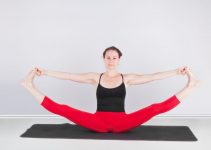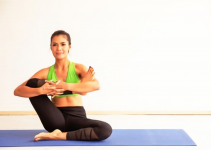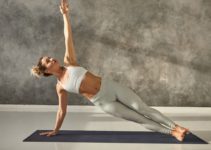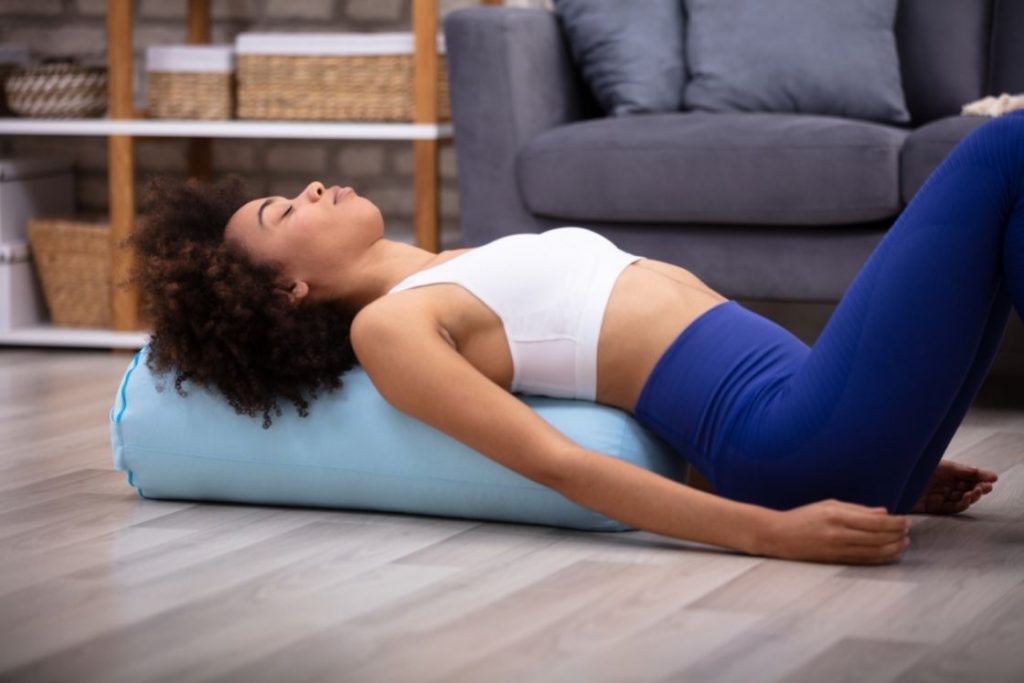
A yoga bolster is a sturdy cylindrical or rectangular cushion filled with buckwheat or hollow fibers. You can see using bolsters in restorative and yin yoga, as well as for meditation and general relaxation purposes.
If you want to practice yoga at home, a yoga bolster is a wonderful investment. By supporting different portions of the body, bolsters can help you relax more in restorative yoga postures.
Yoga bolsters are available in a variety of sizes, shapes, weights, and fillings.
The strong cylindrical shape is ideal for supporting the body in seated, reclining, and supine positions, and may be used to both relax and support the body to help it accomplish even challenging yoga poses.
The firmness of a product is mostly influenced by personal preference and the purpose for which it will be used. You do not however need them to be too soft, as they won’t give full assistance.
Benefits of using a bolster in yoga
The bolster offers a cushion between your body and the hard floor or yoga mat, enabling you to be more comfortable while performing various yoga poses. A bolster isn’t just for beginners; it can be used in a variety of ways to help you with stretches and basic asana.
Some of the other common benefits of using a bolster are:
- Bolster pillows are more rigid than standard bed pillows hence it provides solid support to the body in most postures.
- Placing a bolster beneath your knees will assist your hips in curving your back, relieving strain and tense muscles.
- They’re also good for individuals who have shoulder and hip troubles.
- Bolsters are a great tool when used for pre and postnatal yoga. They also assist during recovery from injury, inflammation, surgery, or an illness.
- A bolster is particularly useful for persons who have a hunchback. It can be used as a chair for back pain relief and posture correction.
- Sitting on a bolster on the floor will better correct your spine versus sitting on a couch. This sitting position is also beneficial to your spine and back muscles.
- Using a bolster can help you attain wider flexion and reap the merits of the pose. It can also help you avoid injuries that would otherwise hinder you from proceeding with a stretch or yoga session.
- It stimulates circulation in the chest and opens the heart chakra when it is laid lengthwise along the mid to upper back, neck, and head.
- To enhance the functioning of the digestive system and gut, placing a bolster under the lower back proves beneficial.
- They are ergonomically friendly and are commonly used to promote relaxation, ease postures, and aid in body opening.
- Bolsters are easy to maintain, store and have a longer life.
8 ways a bolster can be used
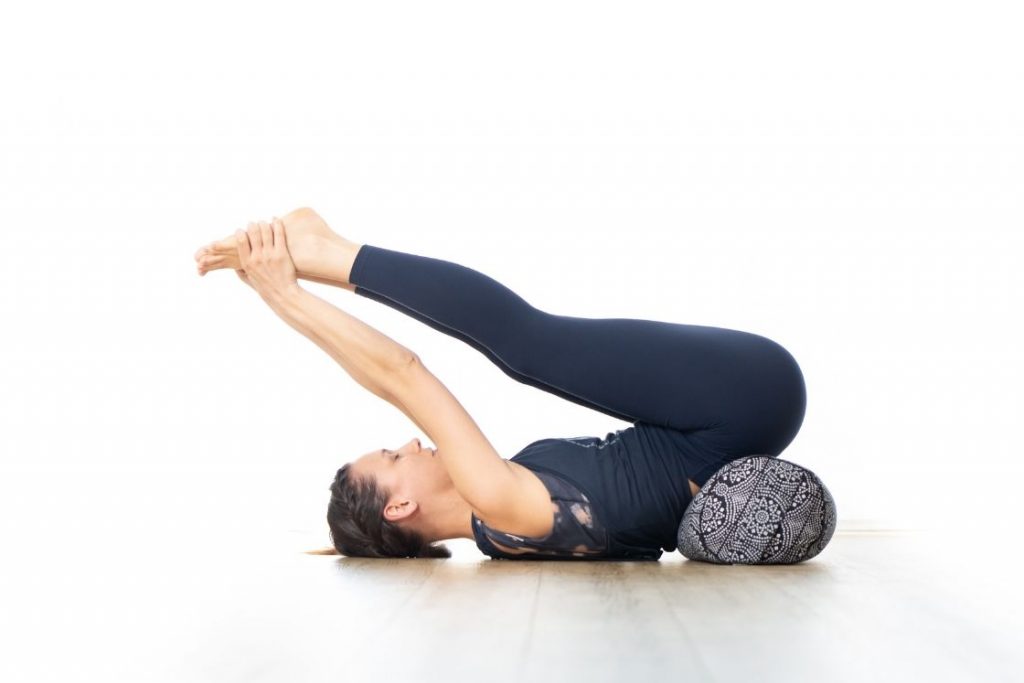
A bolster may be used in your yoga practice whether you are a beginner practicing basic asana and require support or a seasoned practitioner looking for a new stability problem.
Bolsters come into use when utilized for extended holds in restorative postures, meditation, relaxation, and rehabilitative therapy. Experiment with what works and let your ideas run free!
Here are some ways bolsters can be used in yoga:
1. For holding poses
It’s essential to stay relaxed when holding a pose for an extended period to get strength and stamina in related muscles. Whether you have an injury or your body isn’t as flexible as it once was, a bolster might help you hold tougher postures for longer periods.
A bolster will aid in extending your muscles and allowing you to accomplish more difficult yoga poses without placing excessive pressure on the body. When practicing advanced postures with safer practice, a bolster will provide support and contribute substantially.
It allows you to stay in the position for longer and become more familiar with it without generating stress from pressing against a hard surface for an extended time.
2. For restorative poses
The basic goal of restorative yoga is to relieve tension and anxiety. A bolster is flexible enough to rely on in a fold to relieve tension on the stretch. In addition to the long hold, it also compels your mind into a meditative state. If you have numerous bolsters or pillows, stacking and piling them to achieve new heights can be a lot of fun!
To achieve the finest results, it’s key to choose the correct bolster kind. A standard bolster and a cylinder bolster under the knees are commonly used in restorative yoga.
3. For support during inversions
A bolster helps make inversion yoga poses easier and less uncomfortable when you need to get your feet up without placing too much weight on your head. When doing a headstand, for example, you can avoid the uncomfortable friction with the floor by placing a circular bolster underneath your head.
By helping your weight shift easily from feet to the head, bolsters can give the extra height when want to raise your legs up the wall inversion and deepen your headstand or forearm stand.
A bolster under your shoulder blades will assist your posture in the plow pose and shoulder stand.
4. For elevating the hips
When you lay a bolster under your hips, it helps to maintain the upright position of the spine, which automatically aids in improved meditation effects. When doing seated poses, using a bolster can help elevate your hips off the ground and offer your legs more room to open.
The added height provided by a bolster can relax stiff hips and knees, allowing you to stay in the position for extended lengths of time. The increased height helps to support the sacrum and alleviate lower back strain if your spine and sacrum tend to droop in sitting poses.
5. For assisting the spine
The head and chest are frequently held away from the floor during rehabilitation exercises. The bolster provides firm, sturdy support for your torso and head when placed lengthwise under the spine. Positioning a bolster vertically under your spine while meditation mellows down breathing exercises. It opens the body and chest for deeper and longer breaths, which increases performance while doing yoga.
6. For folds and bends
A bolster is useful for easing into forward and backward bend poses such as wheel pose, downward dog, camel pose, seated forward bend, etc. Securing a bolster in the proper position relieves compression and prevents back strain. It increases the effectiveness of challenging and advanced poses when done with an open heart.
The bolster’s extra height allows you to use it as an extension of your arms. You can support your weight with your elbows rather than your wrists in postures like downward dog and cobra, or you can use the softness to cushion your knees in postures like camel or any pose that need you to put weight on your knees.
Using a bolster can also help you improve your ability to perform these poses just with your body in time as you practice.
7. For postnatal yoga
Yoga bolsters can be used to adapt conventional yoga for pregnant women without losing the rewards of the technique. A bolster can support the stomach, prevent it from dropping to the floor, and provide comfortable support for the arms and head. A pregnant lady can execute the side-lying position, Savasana lying on her back, and support forward fold with the yoga bolster.
8. For promoting relaxation
Placing a bolster beneath your knees or behind your back allows you to submit and truly relax your body, allowing you to get the most out of your resting poses. Bolsters are ideal for grounding since they are thick, and the sensory feedback is a fantastic way to keep the mind anchored.
When you don’t have to think about doing your posture correctly for an extended amount of time, using a bolster can help you stay in the present. Relaxation aids in better breathing and stress relief.
Yoga poses modifications with bolster
Before you start practicing with bolsters, determine which type of bolster you would prefer, based on your intention and practice goals.
Because the rectangular bolsters are wider, they provide a little additional support. Whereas a round bolster is slightly narrower, it may cause your shoulders to hang off the side if you have wide shoulders.
Then there’s the matter of the weight. The higher-quality bolsters will be heavier, providing more support and durability. The lighter ones will be wonderful for travel, but not so much for body support.
Decide on the type of support you want and the shape and weight that is right for you.
Below are some examples where you can use bolsters to make the approach to a pose easier:
1. Hero Pose with bolster under hips
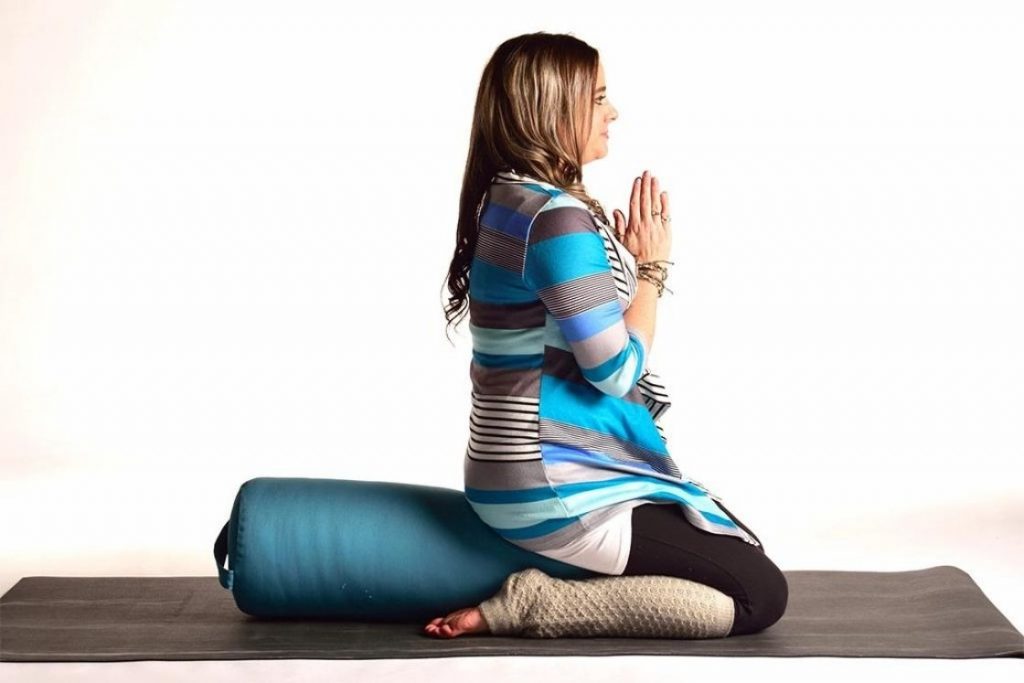
Hero pose is often difficult to sustain as you have to keep your back upright and sit between your lower legs in a kneeling position. Here to minimize strain on your knees, you can use a bolster to lift your hips. It will help with keeping your spine aligned and back straight. It can also help in reducing the strain in your hips, quads, and knees.
- Come to an upright kneeling position with your upper feet flat on the mat.
- Place your hands on the mat and move your feet at a distance slightly more than the hip width. The distance should be enough to place your buttocks between the gap.
- Place a rectangular bolster lengthwise in the gap created.
- The toes should not be tucked in or facing outwards. They should be pointed straight towards the back.
- Slowly, sit down on the bolster. If needed, create more space by manually moving your shins further.
- For stiff ankles, use folded blanket/towel under them. Additionally, use yoga blocks or folded blanket/towel under your knees to reduce strain and friction.
- Keep your spine straight, shoulders away from your ears, and gaze straight towards the front.
- Hold the pose for at least 30 seconds to 1 minute and gradually increase the amount of time.
2. Bridge Pose with bolster under sacrum
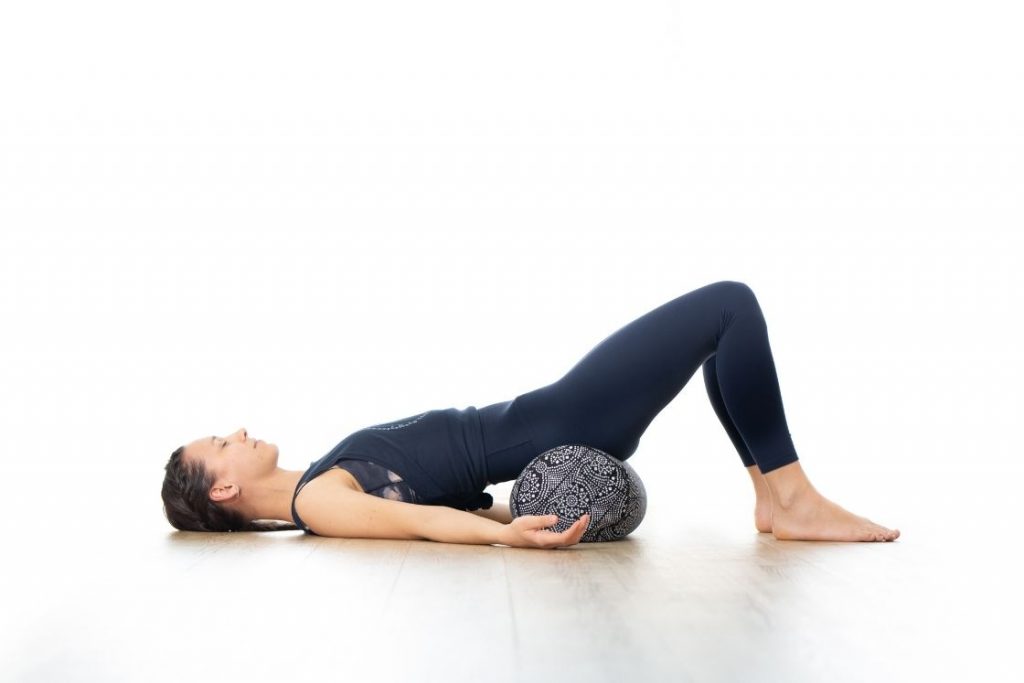
Bridge pose is a mild inversion, chest and hip opener, and a core strengthening pose. Holding the pose after the lift of the hips can be challenging if you are a beginner, have tight hips, thigh, and back muscles along with a stiff shoulder.
Using a bolster in bridge pose will take off some of the pressure from the feet and shoulders. It will make the pose easier to approach and sustain for a longer duration. It makes this a supported bridge pose, commonly used among restorative yoga poses.
If you’re using a rectangular bolster, you can use one or multiple, based on the height of the lift you want to achieve. A cylindrical bolster will also help if you aim to gradually increase the tilt.
- Lie on your back and spread your legs hip-width apart.
- Bend your knees so that your lower legs are perpendicular to the floor and are feet are firmly placed on the mat.
- Keep your hands beside your body, palms facing down. This will also aid in lifting your hips.
- With help of your hamstrings, core muscles, and arms, lift your hips off the floor.
- Place a bolster horizontally under your sacrum. When placed vertically, it will support your lower back and tailbone.
- Additionally, you can also place a rolled blanket under your head.
- Hold this position for 5-7 breaths or as long as you feel comfortable.
3. Fish Pose with bolster under upper back
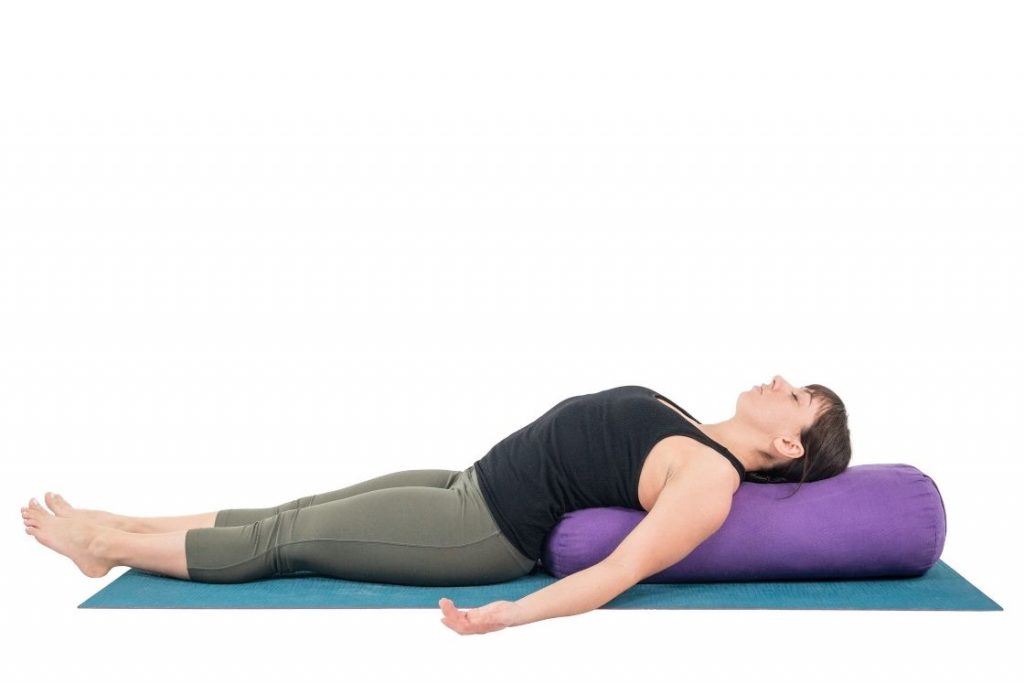
The supported fish pose is a great chest opener and backbend. It helps in reducing the stiffness of the upper back and shoulders. Using a cylindrical bolster under the upper back will help in holding the pose longer and move up and down for a gentle massage and stretch to the upper back muscles.
A rectangular bolster will also be helpful when placed lengthwise. It will support the entire section from the head to the upper back. However, in this case, your shoulders may hang on the sides which you will have to keep lifting on your own.
- Place a cylindrical bolster parallel to the shorter end of the mat. Lie down such that the bolster is in line with your shoulder blades.
- Keep your legs together and stretch them straight or with a slight bend on the knees. You can also add a blanket under your hips.
- Your hands can be placed beside your body, on top of your chest, or bent at the elbows with palms up.
- Stay in this pose for as long as you want.
4. Reclined Bound Angle Pose with bolster supporting back
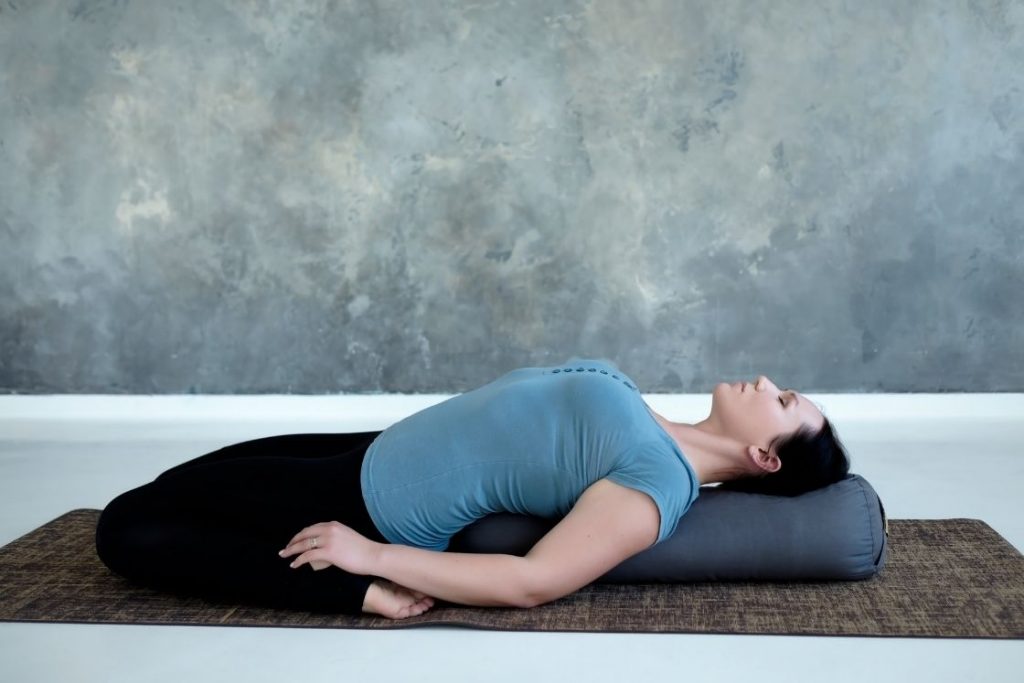
In this pose, you can effectively open your hips as well as your chest. For those who cannot recline due to stiffness of the back or hip muscles or any medical constraints, using bolsters can make this pose restorative and easy to practice.
In reclined bound angle pose, the bolster can be used in many ways. You can place a rectangular bolster lengthwise under your back which will support your torso and neck. Using folded blankets on top of the bolster will give you an elevated head to reduce the strain on the neck.
Use a bolster to keep on top of your pelvis for an added grounding experience.
- Lie down on your yoga mat completely on your back.
- For an elevated torso, you can place a bolster lengthwise on two blocks and adjust the blocks in a way that gives a reclining angle. Or use the technique described above.
- Bend your knees on the sides and bring your feet together at the soles. You can place blocks under each knee, cushions under the thighs, and a folded blanket under your hips.
- Keep your hands at your sides with palms up or on top of your belly.
- Hold this pose for 5-7 breaths or for as long you want.
5. Child’s Pose with bolster to support torso and hands
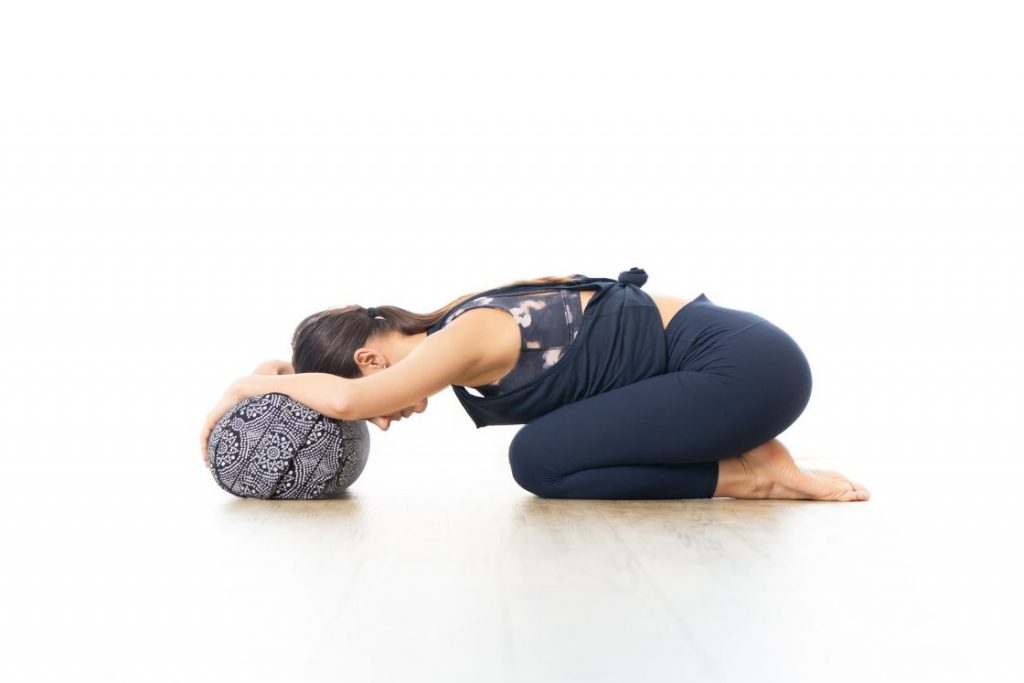
There are multiple ways you can use a bolster in child’s pose. You can place it between your thighs to rest your upper body when your bend forward. A rectangular bolster will be a good choice for this.
You can also place it in front of your head so that you can rest your hands on it once you have reached the full forward fold in child’s pose. If so, select a cylindrical bolster.
Use one of the two options or both simultaneously, either way, you will be able to transform this relaxing pose into a deeply restorative pose in a matter of minutes.
Using bolster can also alleviate any strain in your neck, back, hips, and abdomen.
- Sit on your knees with your big toes touching, buttocks placed on the heels, and your knees hip-width apart.
- Place a bolster between your inner thighs and bend forward to lay your torso on top of it. You can use a rolled towel, pillow, or folded blanket to keep under the back of the thighs in case of tense hips.
- Place your head on top of the bolster to keep it in line with the spine. If you have placed your cheeks, make sure that you keep changing the sides to avoid stiffness in the neck.
- If the bolster’s length is short, place a stack of blocks where you can rest your forehead. You can keep your hands beside you or stretch in front of you.
- Maintain this pose for as long as you like.
6. Legs up the wall Pose with bolster to elevate hips
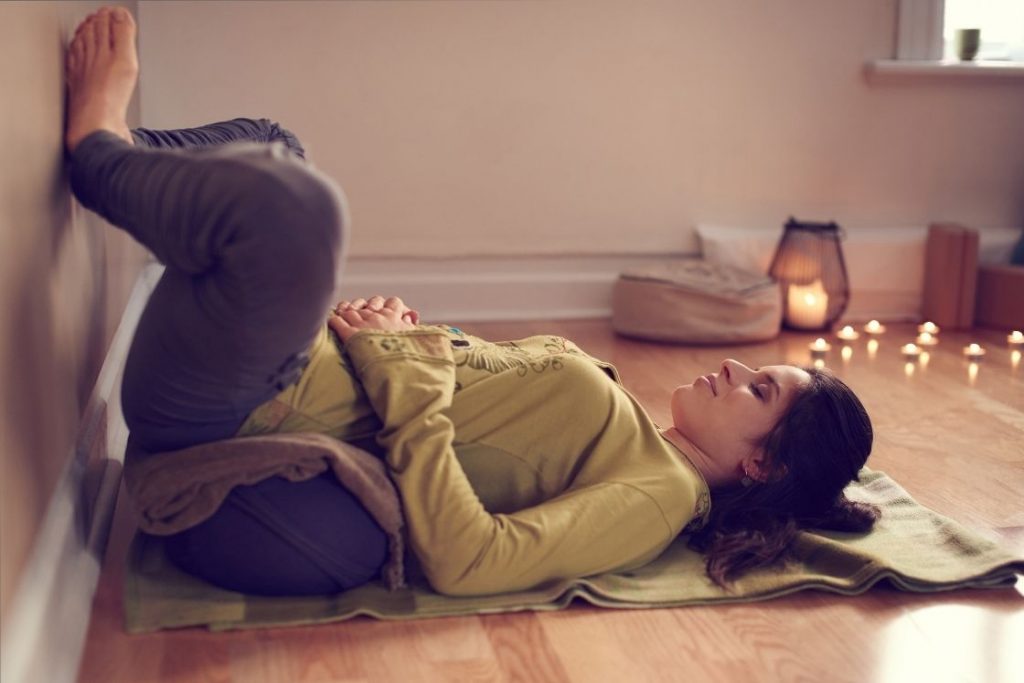
The legs up the wall pose, aka Viparita Karani, is in itself a very relaxing and restorative pose. This pose also comes in the category of mild inversion. When you add bolsters, it raises your hips and increases the inversion. They also act as a support to your hips during pregnancy or if you have a lower back problem.
The choice of the bolster, rectangular or cylindrical, depends on your preference.
- Place the shorter end of the yoga mat close to the wall and keep a bolster on that end.
- On the opposite end of the mat, place a folded blanket or pillow for your head.
- Lie on your back and shimmy close to the wall. Extend your legs towards the roof and rest them on the wall. You also have the liberty to bend your knees if you are unable to keep them straight.
- If you are pregnant or experience discomfort in your back while lying on your back, place a stack of blankets or pillows behind your upper back to elevate at an angle.
- Spread your hands to the side with your fingers spread, place them beside you or on top of your belly.
- You can hold this position for as long as you want but make sure to hold it for at least 5-10 minutes.
7. Corpse Pose
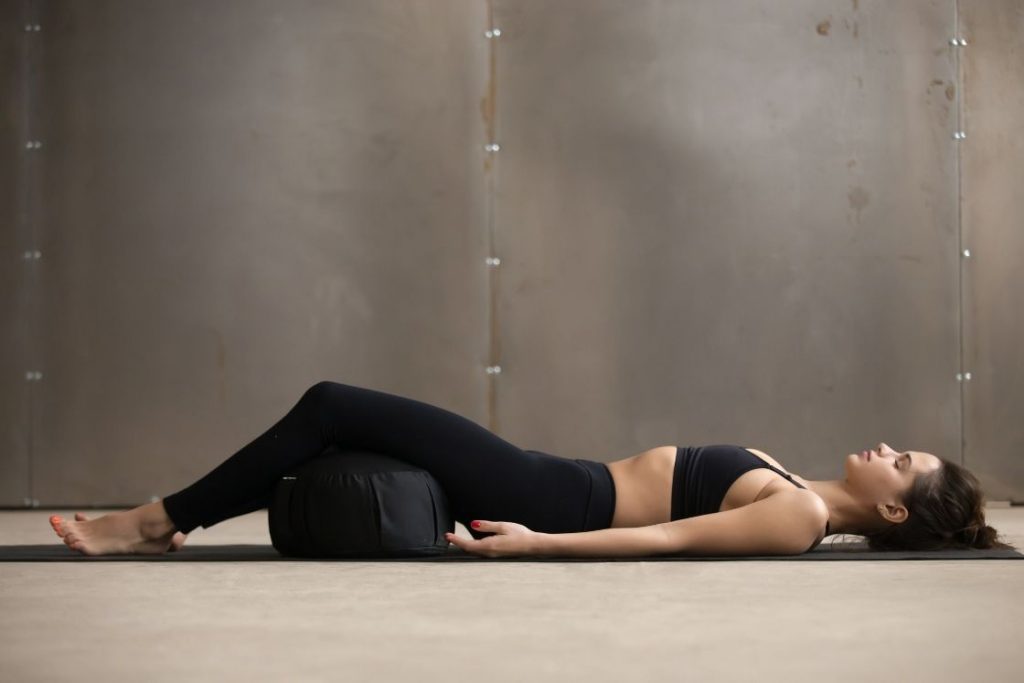
One of the easiest yet the hardest pose is the savasana. It is difficult to stay still however it proves to be one of the best restoratives, calming, and relaxing poses. You can add bolsters in any way here. It will help in increasing the relaxing quotient of the pose.
The bolster can also be used to induce grounding by placing a rectangular bolster on the pelvis, abdomen, or thighs.
- Lie down on your back with your legs stretched out. Use a pillow or a cushion under your head, a bolster under your knees and ankles to keep your legs in a straight line.
- Spread your arms beside you and surrender your weight on the props. Place a bolster under your thighs if you have back pain.
- Just like you used bolster in the fish and reclining bound angle pose, you can place the bolster in the same manner for this pose as well.
- You can also place a small bolster on your chest, abdomen, pelvis, thighs, or lower legs if you feel comfortable. Here you can use a blanket to cover yourself to further induce sleep.
- Lie completely still for a maximum of 15 minutes.
Conclusion
Yoga props provide a plethora of options for varying your practice and putting your body and mind to new challenges. Bolsters are a very adaptable tool that helps you push your yoga practice to new heights. Bolsters can also help you feel better in postures like Yin and Restorative Yoga, which urge you to unwind and let go of stress in your body.
